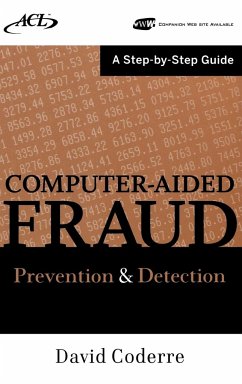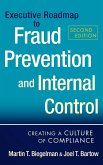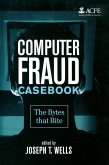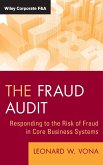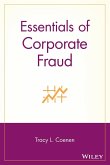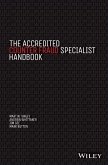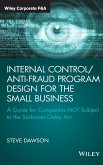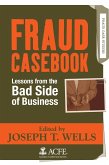- Gebundenes Buch
- Merkliste
- Auf die Merkliste
- Bewerten Bewerten
- Teilen
- Produkt teilen
- Produkterinnerung
- Produkterinnerung
Using software to detect improper transactions are techniques that have grown in importance for fraud examiners. This book provides fraud examiners and auditors with step by step guidance on using data extraction and software to detect and prevent fraud. Its implementation guidance is supplemented by more than 60 case studies. Plus, it enables readers to use data to identify known and unknown symptoms of fraud. Auditors and fraud examiners will discover how to leverage data analysis as a powerful tool to detect and prevent fraud from occurring in any organization.
Andere Kunden interessierten sich auch für
![Executive Roadmap to Fraud Prevention and Internal Control Executive Roadmap to Fraud Prevention and Internal Control]() Martin T. BiegelmanExecutive Roadmap to Fraud Prevention and Internal Control38,99 €
Martin T. BiegelmanExecutive Roadmap to Fraud Prevention and Internal Control38,99 €![Computer Fraud Casebook Computer Fraud Casebook]() Joseph T. WellsComputer Fraud Casebook84,99 €
Joseph T. WellsComputer Fraud Casebook84,99 €![The Fraud Audit The Fraud Audit]() Leonard W. VonaThe Fraud Audit71,99 €
Leonard W. VonaThe Fraud Audit71,99 €![Essentials of Corporate Fraud Essentials of Corporate Fraud]() Tracy CoenenEssentials of Corporate Fraud47,99 €
Tracy CoenenEssentials of Corporate Fraud47,99 €![The Accredited Counter Fraud Specialist Handbook The Accredited Counter Fraud Specialist Handbook]() Martin TunleyThe Accredited Counter Fraud Specialist Handbook80,99 €
Martin TunleyThe Accredited Counter Fraud Specialist Handbook80,99 €![Internal Control/Anti-Fraud Program Design for the Small Business Internal Control/Anti-Fraud Program Design for the Small Business]() Steve DawsonInternal Control/Anti-Fraud Program Design for the Small Business69,99 €
Steve DawsonInternal Control/Anti-Fraud Program Design for the Small Business69,99 €![Fraud Casebook Fraud Casebook]() Joseph T. WellsFraud Casebook94,99 €
Joseph T. WellsFraud Casebook94,99 €-
-
-
Using software to detect improper transactions are techniques that have grown in importance for fraud examiners. This book provides fraud examiners and auditors with step by step guidance on using data extraction and software to detect and prevent fraud. Its implementation guidance is supplemented by more than 60 case studies. Plus, it enables readers to use data to identify known and unknown symptoms of fraud. Auditors and fraud examiners will discover how to leverage data analysis as a powerful tool to detect and prevent fraud from occurring in any organization.
Hinweis: Dieser Artikel kann nur an eine deutsche Lieferadresse ausgeliefert werden.
Hinweis: Dieser Artikel kann nur an eine deutsche Lieferadresse ausgeliefert werden.
Produktdetails
- Produktdetails
- Verlag: Wiley & Sons
- 1. Auflage
- Seitenzahl: 304
- Erscheinungstermin: 23. März 2009
- Englisch
- Abmessung: 235mm x 157mm x 21mm
- Gewicht: 510g
- ISBN-13: 9780470392430
- ISBN-10: 0470392436
- Artikelnr.: 25836663
- Herstellerkennzeichnung
- Libri GmbH
- Europaallee 1
- 36244 Bad Hersfeld
- gpsr@libri.de
- Verlag: Wiley & Sons
- 1. Auflage
- Seitenzahl: 304
- Erscheinungstermin: 23. März 2009
- Englisch
- Abmessung: 235mm x 157mm x 21mm
- Gewicht: 510g
- ISBN-13: 9780470392430
- ISBN-10: 0470392436
- Artikelnr.: 25836663
- Herstellerkennzeichnung
- Libri GmbH
- Europaallee 1
- 36244 Bad Hersfeld
- gpsr@libri.de
David Coderre has over twenty years of experience in internal audit, management consulting, policy development, manage-ment information systems, system development, and application implementation areas. He is currently President of CAATS (Computer-Assisted Analysis Techniques and Solutions). He is the author of three highly regarded books on using data analysis for audit and fraud detection.
Case Studies.
Preface.
CHAPTER 1: What Is Fraud?
Fraud: A Definition.
Why Fraud Happens.
Who Is Responsible for Fraud Detection?
What Is a Fraud Awareness Program?
Screening Job Applicants.
What Is a Corporate Fraud Policy?
Notes.
CHAPTER 2: Fraud Prevention and Detection.
Detecting Fraud.
Determining the Exposure to Fraud.
Assessing the Risk that Fraud Is Occurring (or Will Occur).
External Symptoms.
Identifying Areas of High Risk for Fraud.
Looking at the Exposures from the Fraudster's Perspective.
Approach 1: Control Weaknesses.
Who Could Benefit from the Identified Control Weaknesses?
What Can They Influence, Control, or Affect?
Can They Act Alone or Is Collusion Required?
Approach 2: Key Fields.
Which Data Fields Can Be Manipulated and by Whom?
Additional Fraud Risk Considerations.
Understanding the Symptoms of Fraud.
Being Alert to the Symptoms of Fraud.
Building Programs to Look for Symptoms.
Investigating and Reporting Instances of Fraud.
Implementing Controls for Fraud Prevention.
Notes.
CHAPTER 3: Why Use Data Analysis to Detect Fraud?
Increased Reliance on Computers.
Developing CAATTs Capabilities.
Integrated Analysis and Value-Added Audit.
Recognizing Opportunities for CAATTs.
Developing a Fraud Investigation Plan.
Allegation.
Objective.
Audit Team.
Schedule.
Data Source.
Analysis.
Legal Authority.
Notes.
CHAPTER 4: Solving the Data Problem.
Setting Audit Objectives.
Defining the Information Requirements.
Accessing Data.
Data Paths.
Data File Attributes and Structures.
Assessing Data Integrity.
Overview of the Application System.
Overview of the Data.
Notes.
CHAPTER 5: Understanding the Data.
Computer Analysis.
Analysis Techniques.
Filter/Display Criteria.
Expressions/Equations.
Gaps.
Statistical Analysis.
Duplicates.
Sort/Index.
Summarization.
Stratification.
Cross Tabulation/Pivot Tables.
Aging.
Join/Relate.
Trend Analysis.
Regression Analysis.
Parallel Simulation.
Benford's Law.
Digital Analysis.
Confirmation Letters.
Sampling.
Combining Techniques.
Assessing the Completeness of the Data.
Filter or Display Criteria.
Expression/Equation.
Gaps.
Statistical Analysis.
Duplicates.
Sorting and Indexing.
Notes.
CHAPTER 6: Overview of the Data.
Summarization.
Stratification.
Cross Tabulation/Pivot Tables.
CHAPTER 7: Working with the Data.
Aging.
Join/Relation.
CHAPTER 8: Analyzing Trends in the Data.
Trend Analysis.
Regression Analysis.
Parallel Simulation.
Notes.
CHAPTER 9: Known Symptoms of Fraud.
Known and Unknown Symptoms.
Fraud in the Payroll Area.
Ghost Employees.
Terminated Employees.
Overpayment.
Fraud in the Purchasing Area.
Employee Activities.
Vendor Action and Employee Inaction.
Collusion between Vendor and Employee.
Symptoms of Purchasing Fraud.
Kickbacks.
Fixed Bidding.
Goods Not Received.
Duplicate Invoices.
Inflated Prices.
Inferior Quality.
Excess Quantities.
CHAPTER 10: Unknown Symptoms of Fraud.
(Using Digital Analysis).
Data Profiling.
Statistical Analysis.
Stratification.
Frequently Used Values.
Even Amounts and Rounding.
Least/Most Used Categories.
Ratio/Variance Analysis.
Maximum/Minimum.
Maximum/Second Highest.
Current/Previous.
One Business Area/Another.
Benford's Law.
Notes.
CHAPTER 11: Automating the Detection Process.
Fraud Applications or Templates.
Fraud Application Development.
CHAPTER 12: Verifying the Results.
Confirmation Letters.
Sampling.
Judgmental or Directed Sampling.
Statistical Sampling.
Quality Assurance.
Quality Assurance Methodology.
Preventive Controls.
Detective Controls.
Corrective Controls.
Ensuring Reliability.
Data Analysis and Prosecuting Fraud.
Notes.
APPENDIX 1: Fraud Investigation Plans.
Insurance Policies-Too Good to Be True.
Paid by the Numbers.
APPENDIX 2: Application of CAATTs by Functional Area.
Accounts Receivable Tests.
Accounts Payable Tests.
General Ledger Tests.
Materials Management and Inventory Control Tests.
Salary and Payroll Tests.
Purchase Order Management Tests.
Conflict-of-Interest Tests.
Kickback Tests.
Bid-Rigging Tests.
Policy and Administration Tests.
Vendor Management Tests.
Retail Loss Prevention Tests.
Sales Analysis Tests.
Work in Progress Tests.
Cash Disbursement Tests.
Customer Service Management Tests.
Loan Tests.
Deposit Tests.
Real Estate Loans.
Credit Card Management.
Life Insurance Tests.
Travel Claims.
APPENDIX 3: ACL Installation Process.
Epilogue.
References.
Index.
Preface.
CHAPTER 1: What Is Fraud?
Fraud: A Definition.
Why Fraud Happens.
Who Is Responsible for Fraud Detection?
What Is a Fraud Awareness Program?
Screening Job Applicants.
What Is a Corporate Fraud Policy?
Notes.
CHAPTER 2: Fraud Prevention and Detection.
Detecting Fraud.
Determining the Exposure to Fraud.
Assessing the Risk that Fraud Is Occurring (or Will Occur).
External Symptoms.
Identifying Areas of High Risk for Fraud.
Looking at the Exposures from the Fraudster's Perspective.
Approach 1: Control Weaknesses.
Who Could Benefit from the Identified Control Weaknesses?
What Can They Influence, Control, or Affect?
Can They Act Alone or Is Collusion Required?
Approach 2: Key Fields.
Which Data Fields Can Be Manipulated and by Whom?
Additional Fraud Risk Considerations.
Understanding the Symptoms of Fraud.
Being Alert to the Symptoms of Fraud.
Building Programs to Look for Symptoms.
Investigating and Reporting Instances of Fraud.
Implementing Controls for Fraud Prevention.
Notes.
CHAPTER 3: Why Use Data Analysis to Detect Fraud?
Increased Reliance on Computers.
Developing CAATTs Capabilities.
Integrated Analysis and Value-Added Audit.
Recognizing Opportunities for CAATTs.
Developing a Fraud Investigation Plan.
Allegation.
Objective.
Audit Team.
Schedule.
Data Source.
Analysis.
Legal Authority.
Notes.
CHAPTER 4: Solving the Data Problem.
Setting Audit Objectives.
Defining the Information Requirements.
Accessing Data.
Data Paths.
Data File Attributes and Structures.
Assessing Data Integrity.
Overview of the Application System.
Overview of the Data.
Notes.
CHAPTER 5: Understanding the Data.
Computer Analysis.
Analysis Techniques.
Filter/Display Criteria.
Expressions/Equations.
Gaps.
Statistical Analysis.
Duplicates.
Sort/Index.
Summarization.
Stratification.
Cross Tabulation/Pivot Tables.
Aging.
Join/Relate.
Trend Analysis.
Regression Analysis.
Parallel Simulation.
Benford's Law.
Digital Analysis.
Confirmation Letters.
Sampling.
Combining Techniques.
Assessing the Completeness of the Data.
Filter or Display Criteria.
Expression/Equation.
Gaps.
Statistical Analysis.
Duplicates.
Sorting and Indexing.
Notes.
CHAPTER 6: Overview of the Data.
Summarization.
Stratification.
Cross Tabulation/Pivot Tables.
CHAPTER 7: Working with the Data.
Aging.
Join/Relation.
CHAPTER 8: Analyzing Trends in the Data.
Trend Analysis.
Regression Analysis.
Parallel Simulation.
Notes.
CHAPTER 9: Known Symptoms of Fraud.
Known and Unknown Symptoms.
Fraud in the Payroll Area.
Ghost Employees.
Terminated Employees.
Overpayment.
Fraud in the Purchasing Area.
Employee Activities.
Vendor Action and Employee Inaction.
Collusion between Vendor and Employee.
Symptoms of Purchasing Fraud.
Kickbacks.
Fixed Bidding.
Goods Not Received.
Duplicate Invoices.
Inflated Prices.
Inferior Quality.
Excess Quantities.
CHAPTER 10: Unknown Symptoms of Fraud.
(Using Digital Analysis).
Data Profiling.
Statistical Analysis.
Stratification.
Frequently Used Values.
Even Amounts and Rounding.
Least/Most Used Categories.
Ratio/Variance Analysis.
Maximum/Minimum.
Maximum/Second Highest.
Current/Previous.
One Business Area/Another.
Benford's Law.
Notes.
CHAPTER 11: Automating the Detection Process.
Fraud Applications or Templates.
Fraud Application Development.
CHAPTER 12: Verifying the Results.
Confirmation Letters.
Sampling.
Judgmental or Directed Sampling.
Statistical Sampling.
Quality Assurance.
Quality Assurance Methodology.
Preventive Controls.
Detective Controls.
Corrective Controls.
Ensuring Reliability.
Data Analysis and Prosecuting Fraud.
Notes.
APPENDIX 1: Fraud Investigation Plans.
Insurance Policies-Too Good to Be True.
Paid by the Numbers.
APPENDIX 2: Application of CAATTs by Functional Area.
Accounts Receivable Tests.
Accounts Payable Tests.
General Ledger Tests.
Materials Management and Inventory Control Tests.
Salary and Payroll Tests.
Purchase Order Management Tests.
Conflict-of-Interest Tests.
Kickback Tests.
Bid-Rigging Tests.
Policy and Administration Tests.
Vendor Management Tests.
Retail Loss Prevention Tests.
Sales Analysis Tests.
Work in Progress Tests.
Cash Disbursement Tests.
Customer Service Management Tests.
Loan Tests.
Deposit Tests.
Real Estate Loans.
Credit Card Management.
Life Insurance Tests.
Travel Claims.
APPENDIX 3: ACL Installation Process.
Epilogue.
References.
Index.
Case Studies.
Preface.
CHAPTER 1: What Is Fraud?
Fraud: A Definition.
Why Fraud Happens.
Who Is Responsible for Fraud Detection?
What Is a Fraud Awareness Program?
Screening Job Applicants.
What Is a Corporate Fraud Policy?
Notes.
CHAPTER 2: Fraud Prevention and Detection.
Detecting Fraud.
Determining the Exposure to Fraud.
Assessing the Risk that Fraud Is Occurring (or Will Occur).
External Symptoms.
Identifying Areas of High Risk for Fraud.
Looking at the Exposures from the Fraudster's Perspective.
Approach 1: Control Weaknesses.
Who Could Benefit from the Identified Control Weaknesses?
What Can They Influence, Control, or Affect?
Can They Act Alone or Is Collusion Required?
Approach 2: Key Fields.
Which Data Fields Can Be Manipulated and by Whom?
Additional Fraud Risk Considerations.
Understanding the Symptoms of Fraud.
Being Alert to the Symptoms of Fraud.
Building Programs to Look for Symptoms.
Investigating and Reporting Instances of Fraud.
Implementing Controls for Fraud Prevention.
Notes.
CHAPTER 3: Why Use Data Analysis to Detect Fraud?
Increased Reliance on Computers.
Developing CAATTs Capabilities.
Integrated Analysis and Value-Added Audit.
Recognizing Opportunities for CAATTs.
Developing a Fraud Investigation Plan.
Allegation.
Objective.
Audit Team.
Schedule.
Data Source.
Analysis.
Legal Authority.
Notes.
CHAPTER 4: Solving the Data Problem.
Setting Audit Objectives.
Defining the Information Requirements.
Accessing Data.
Data Paths.
Data File Attributes and Structures.
Assessing Data Integrity.
Overview of the Application System.
Overview of the Data.
Notes.
CHAPTER 5: Understanding the Data.
Computer Analysis.
Analysis Techniques.
Filter/Display Criteria.
Expressions/Equations.
Gaps.
Statistical Analysis.
Duplicates.
Sort/Index.
Summarization.
Stratification.
Cross Tabulation/Pivot Tables.
Aging.
Join/Relate.
Trend Analysis.
Regression Analysis.
Parallel Simulation.
Benford's Law.
Digital Analysis.
Confirmation Letters.
Sampling.
Combining Techniques.
Assessing the Completeness of the Data.
Filter or Display Criteria.
Expression/Equation.
Gaps.
Statistical Analysis.
Duplicates.
Sorting and Indexing.
Notes.
CHAPTER 6: Overview of the Data.
Summarization.
Stratification.
Cross Tabulation/Pivot Tables.
CHAPTER 7: Working with the Data.
Aging.
Join/Relation.
CHAPTER 8: Analyzing Trends in the Data.
Trend Analysis.
Regression Analysis.
Parallel Simulation.
Notes.
CHAPTER 9: Known Symptoms of Fraud.
Known and Unknown Symptoms.
Fraud in the Payroll Area.
Ghost Employees.
Terminated Employees.
Overpayment.
Fraud in the Purchasing Area.
Employee Activities.
Vendor Action and Employee Inaction.
Collusion between Vendor and Employee.
Symptoms of Purchasing Fraud.
Kickbacks.
Fixed Bidding.
Goods Not Received.
Duplicate Invoices.
Inflated Prices.
Inferior Quality.
Excess Quantities.
CHAPTER 10: Unknown Symptoms of Fraud.
(Using Digital Analysis).
Data Profiling.
Statistical Analysis.
Stratification.
Frequently Used Values.
Even Amounts and Rounding.
Least/Most Used Categories.
Ratio/Variance Analysis.
Maximum/Minimum.
Maximum/Second Highest.
Current/Previous.
One Business Area/Another.
Benford's Law.
Notes.
CHAPTER 11: Automating the Detection Process.
Fraud Applications or Templates.
Fraud Application Development.
CHAPTER 12: Verifying the Results.
Confirmation Letters.
Sampling.
Judgmental or Directed Sampling.
Statistical Sampling.
Quality Assurance.
Quality Assurance Methodology.
Preventive Controls.
Detective Controls.
Corrective Controls.
Ensuring Reliability.
Data Analysis and Prosecuting Fraud.
Notes.
APPENDIX 1: Fraud Investigation Plans.
Insurance Policies-Too Good to Be True.
Paid by the Numbers.
APPENDIX 2: Application of CAATTs by Functional Area.
Accounts Receivable Tests.
Accounts Payable Tests.
General Ledger Tests.
Materials Management and Inventory Control Tests.
Salary and Payroll Tests.
Purchase Order Management Tests.
Conflict-of-Interest Tests.
Kickback Tests.
Bid-Rigging Tests.
Policy and Administration Tests.
Vendor Management Tests.
Retail Loss Prevention Tests.
Sales Analysis Tests.
Work in Progress Tests.
Cash Disbursement Tests.
Customer Service Management Tests.
Loan Tests.
Deposit Tests.
Real Estate Loans.
Credit Card Management.
Life Insurance Tests.
Travel Claims.
APPENDIX 3: ACL Installation Process.
Epilogue.
References.
Index.
Preface.
CHAPTER 1: What Is Fraud?
Fraud: A Definition.
Why Fraud Happens.
Who Is Responsible for Fraud Detection?
What Is a Fraud Awareness Program?
Screening Job Applicants.
What Is a Corporate Fraud Policy?
Notes.
CHAPTER 2: Fraud Prevention and Detection.
Detecting Fraud.
Determining the Exposure to Fraud.
Assessing the Risk that Fraud Is Occurring (or Will Occur).
External Symptoms.
Identifying Areas of High Risk for Fraud.
Looking at the Exposures from the Fraudster's Perspective.
Approach 1: Control Weaknesses.
Who Could Benefit from the Identified Control Weaknesses?
What Can They Influence, Control, or Affect?
Can They Act Alone or Is Collusion Required?
Approach 2: Key Fields.
Which Data Fields Can Be Manipulated and by Whom?
Additional Fraud Risk Considerations.
Understanding the Symptoms of Fraud.
Being Alert to the Symptoms of Fraud.
Building Programs to Look for Symptoms.
Investigating and Reporting Instances of Fraud.
Implementing Controls for Fraud Prevention.
Notes.
CHAPTER 3: Why Use Data Analysis to Detect Fraud?
Increased Reliance on Computers.
Developing CAATTs Capabilities.
Integrated Analysis and Value-Added Audit.
Recognizing Opportunities for CAATTs.
Developing a Fraud Investigation Plan.
Allegation.
Objective.
Audit Team.
Schedule.
Data Source.
Analysis.
Legal Authority.
Notes.
CHAPTER 4: Solving the Data Problem.
Setting Audit Objectives.
Defining the Information Requirements.
Accessing Data.
Data Paths.
Data File Attributes and Structures.
Assessing Data Integrity.
Overview of the Application System.
Overview of the Data.
Notes.
CHAPTER 5: Understanding the Data.
Computer Analysis.
Analysis Techniques.
Filter/Display Criteria.
Expressions/Equations.
Gaps.
Statistical Analysis.
Duplicates.
Sort/Index.
Summarization.
Stratification.
Cross Tabulation/Pivot Tables.
Aging.
Join/Relate.
Trend Analysis.
Regression Analysis.
Parallel Simulation.
Benford's Law.
Digital Analysis.
Confirmation Letters.
Sampling.
Combining Techniques.
Assessing the Completeness of the Data.
Filter or Display Criteria.
Expression/Equation.
Gaps.
Statistical Analysis.
Duplicates.
Sorting and Indexing.
Notes.
CHAPTER 6: Overview of the Data.
Summarization.
Stratification.
Cross Tabulation/Pivot Tables.
CHAPTER 7: Working with the Data.
Aging.
Join/Relation.
CHAPTER 8: Analyzing Trends in the Data.
Trend Analysis.
Regression Analysis.
Parallel Simulation.
Notes.
CHAPTER 9: Known Symptoms of Fraud.
Known and Unknown Symptoms.
Fraud in the Payroll Area.
Ghost Employees.
Terminated Employees.
Overpayment.
Fraud in the Purchasing Area.
Employee Activities.
Vendor Action and Employee Inaction.
Collusion between Vendor and Employee.
Symptoms of Purchasing Fraud.
Kickbacks.
Fixed Bidding.
Goods Not Received.
Duplicate Invoices.
Inflated Prices.
Inferior Quality.
Excess Quantities.
CHAPTER 10: Unknown Symptoms of Fraud.
(Using Digital Analysis).
Data Profiling.
Statistical Analysis.
Stratification.
Frequently Used Values.
Even Amounts and Rounding.
Least/Most Used Categories.
Ratio/Variance Analysis.
Maximum/Minimum.
Maximum/Second Highest.
Current/Previous.
One Business Area/Another.
Benford's Law.
Notes.
CHAPTER 11: Automating the Detection Process.
Fraud Applications or Templates.
Fraud Application Development.
CHAPTER 12: Verifying the Results.
Confirmation Letters.
Sampling.
Judgmental or Directed Sampling.
Statistical Sampling.
Quality Assurance.
Quality Assurance Methodology.
Preventive Controls.
Detective Controls.
Corrective Controls.
Ensuring Reliability.
Data Analysis and Prosecuting Fraud.
Notes.
APPENDIX 1: Fraud Investigation Plans.
Insurance Policies-Too Good to Be True.
Paid by the Numbers.
APPENDIX 2: Application of CAATTs by Functional Area.
Accounts Receivable Tests.
Accounts Payable Tests.
General Ledger Tests.
Materials Management and Inventory Control Tests.
Salary and Payroll Tests.
Purchase Order Management Tests.
Conflict-of-Interest Tests.
Kickback Tests.
Bid-Rigging Tests.
Policy and Administration Tests.
Vendor Management Tests.
Retail Loss Prevention Tests.
Sales Analysis Tests.
Work in Progress Tests.
Cash Disbursement Tests.
Customer Service Management Tests.
Loan Tests.
Deposit Tests.
Real Estate Loans.
Credit Card Management.
Life Insurance Tests.
Travel Claims.
APPENDIX 3: ACL Installation Process.
Epilogue.
References.
Index.

